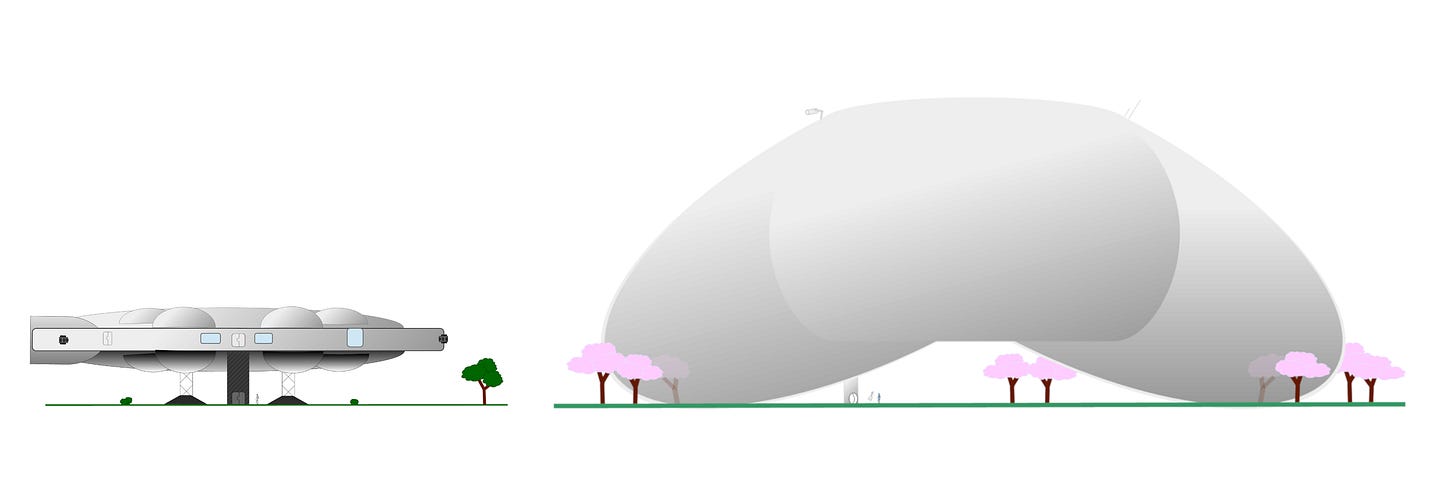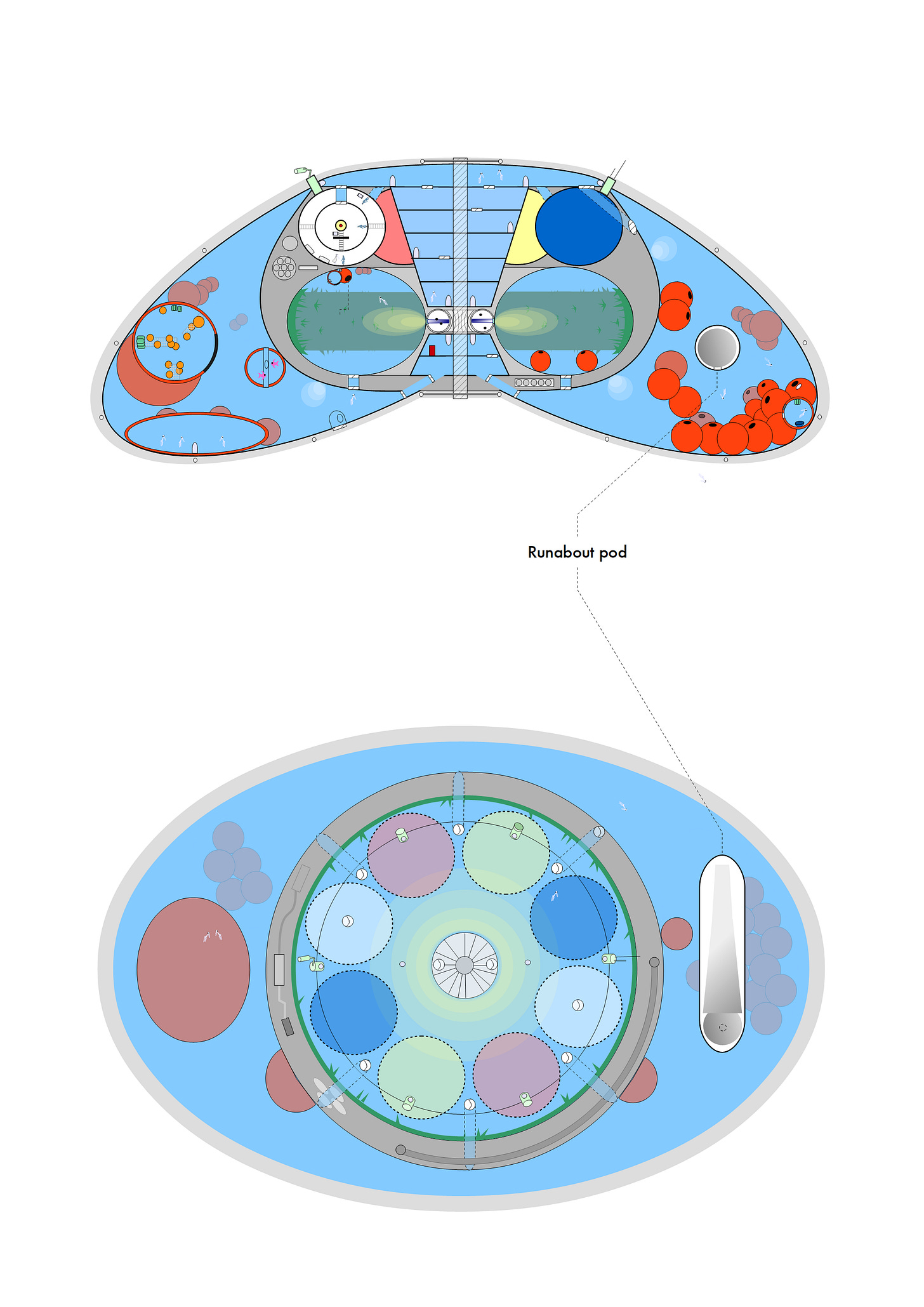The Uutaruu voyager-class starship derives its shape from a rising bubble in water — it being a fairly efficient shape to rise out of the shallow oceans of their home world with limited disruption (at least at a standard velocity). Humans seeing it for the first time will marvel in disbelief at how minimal the surface disruption is.
Uutaruu ships are generally filled with water to best serve the species’ aquatic nature. Depending on configuration, there may be one or more pods for non-aquatic species or cargo. The ship essentially reproduces the conditions for building typical shelter structures in their natural environment — much like human ships re-create buildings filled with air on Earth. But like rooms on a human ship, the resulting structures are more modular and cramped compared to their home-world analogs. Gravity is not as essential to the Uutaruu, being able to control their buoyancy, but it does mean they use their siphons to jet more on a ship1. However, they will equip pods for terrestrial species with artificial gravity created by a uniform spherical entropy gradient.
The main crew facilities are highly configurable with different kinds of pods. There is a general separation into two parts: the central core which contains the technology systems (and hyperquantum computer) (the “technical decks”), and the bulk space that can be configured for cargo and crew.
Individual crew pods are capable of surviving in space and sustaining 2-3 Uutaruu each for several weeks and work like escape pods should it become necessary to abandon ship. The limiting factor is the heat loss to space — the interior eventually becomes too cold whereupon an Uutaruu will enter a torpor state and (rarely) have survived being frozen solid. There are explosive charges that will rupture the external hull to allow the various pods to break free.
A ubiquitous pod on Uutaruu ships are the crew assembly halls. Uutaruu are a highly social species and for their mental health they will gather in the assembly hall roughly twice daily (“morning” and “evening”) to communicate both telepathically and with their skin marking language. Skipping these meetings due to e.g. work is socially similar to skipping breakfast or dinner for humans — with similar enervating consequences.
However, Uutaruu do not engage in communal eating. They were never social hunters in their pre-history nor did they have separation of food production, gathering, or preparation tasks2. Living in an abundant coral reef biome, all Uutaruu from infancy are readily able to capture food which was generally always nearby. As such, they have live Eukhloe or small creatures swimming freely in their crew pods and will retreat there to eat.
The toroidal confinement hyperquantum singularity drive is used both in normal “teleport” mode as well as in “grad” (gradient) mode where an entropy gradient sets up a constant gravitational force on the vehicle — allowing it to accelerate in any direction (see here for more on “grad” mode). As such, there are no thrusters and only a back-up conventional hyperquantum computer available in the event of a primary computer failure.
Unlike human ships, there is no special system (e.g. Ba IV) acting as the entropy reservoir. The unavoidable errors in the hyperquantum computation — bounded by the laws of physics to be non-zero — are filtered to accrue in the water filling the ship. In particular, the separate toroidal volume containing the Eukhloe beds is used and the Uutaruu evacuate that area when performing hyperquantum jumps. The effect is to raise the temperature of the water in that compartment, keeping it relatively warm despite the fact that the net result of a hyperquantum jump requires the total system temperature to decrease3.
The hyperquantum drive has an X-ray window that allows high energy photons to be emitted which are down-converted to optical photons by a crystal. Those photons act as solar input for the Eukloe beds that line the interior of another toroidal area. The Eukloe produces all the oxygen and consumes the excess carbon dioxide4. Hygiene pods process waste to a form that is used as food for the Eukhloe — however other nutrients are also carried as the waste alone is insufficient.
An Uutaruu voyager-class ship was the one that made first contact with humans in the 22nd century, landing outside the old national assembly hall in Seoul:
Approximate scale comparison to the Ulysses:
Update
Added a version that includes a runabout inside a vacuum pod:
This basically means exercise is a constant so no dedicated facilities are needed.
They are fascinated by this human institution and will almost always join if asked. However, if more than one Uutaruu comes to dinner, often neither will eat because it is socially unacceptable in almost all Uutaruu cultures on their home world (exception among the south polar Uutaruu as their historical food collection activity was nearly constant). Some Uutaruu who have been among humans longer will be less strict about this.
The decrease theoretically can be no less than the Unruh temperature of the local gravitational vector acceleration. However, no hyperquantum drive is efficient enough to reach the bound. In the 24th century, most are efficient enough for the temperature drop to be imperceptible with less advanced human systems still leaving a slight chill.
Uutaruu evolved on a world with almost identical biochemistry as Earth — even the same chirality. As such, they need oxygen for aerobic respiration (and photosynthetic plants produce CO2). The biggest difference are the codons which code for entirely different amino acids — so the genes and DNA are basically incompatible.








